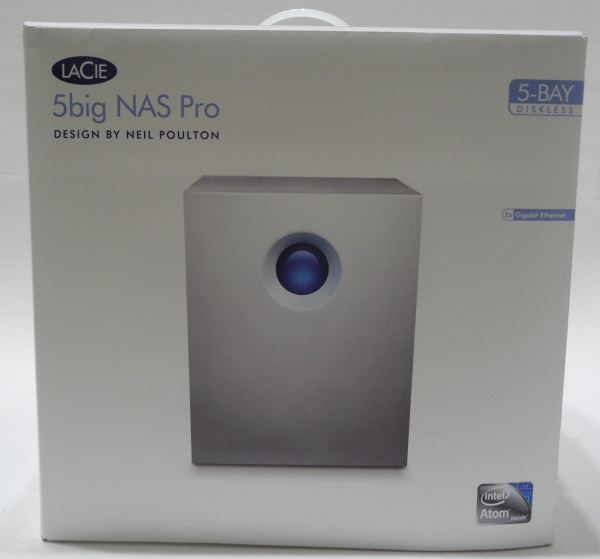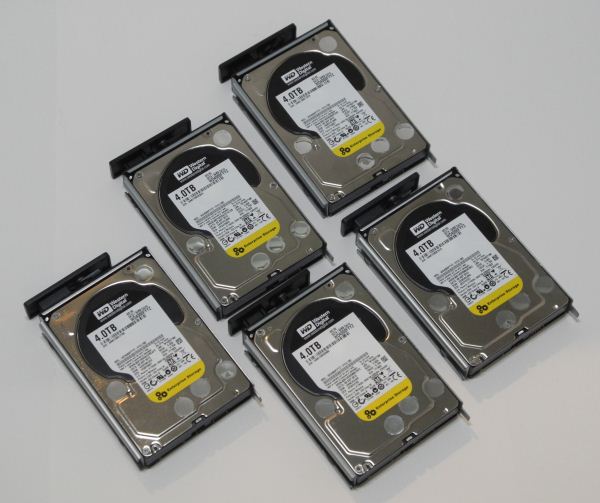LaCie 5big NAS Pro Review - Part I
by Ganesh T S on January 7, 2013 7:00 PM EST- Posted in
- Enterprise
- Storage
- NAS
- LaCie
Introduction and Testbed Setup
We have looked at LaCie's 5big offering before in late 2010. In that product, the only LaCie signature was the industrial design and choice of hardware components of the NAS. The performance figures were left to Windows Storage Server 2008 R2. The time has now come for LaCie to move forward with their own custom NAS OS based on Debian Linux for their 5-bay configuration.
The 2big NAS offering had impressed us with its performance in a 2-bay configuration for SOHO and SMB applications involving a few users. However, translating that performance to a 5-bay multi-user SMB scenario is definitely challenging. On top of that, the SMB / SOHO NAS market is quite hot, with multiple players competing in terms of features and price. For the 5big NAS Pro to make an impression in the market, it needs to perform well and also differentiate itself enough for the consumers to pay attention.
Towards the end of December, LaCie came to us with a proposition to beta-test their 5big NAS Pro. As is customary in such cases, we weren't allowed to disclose performance benchmarks before the official launch date. The additional caveat was that the lift of the NDA would be tied to our evaluation. In case we found any show-stopper bugs, we had to wait for the FCS (first customer shipment) firmware to launch and present our results with the updated firmware. In the interest of full disclosure, this means that today's piece is more of a report of our beta-testing (and hence, Part I) rather than a full-length review. At the outset, LaCie indicated that the firmware we had on our unit was more focused on the differentiating features rather than providing all the planned software features for the product right away.
Hardware
The 5big NAS Pro is a 5-bay Atom-based NAS with 4 GB of RAM. LaCie doesn't document the exact processor model, but does mention that the dual core Atom runs at 2.13 GHz. It is possible that customers might received either a D2550 or D2700 based unit (Update: LaCie confirmed that all consumers will receive a D2700-based unit only).. The hardware design is the same as that of the 5big Storage Server we reviewed in 2010 except for some changes in the ports at the rear of the unit. Instead of the (1x eSATA, 3x USB 2.0, 1x VGA, 2x GbE LAN) in the 5big Storage Server, we have (2x USB 2.0, 2x USB 3.0, 1x VGA, 2x GbE LAN) due to the platform update. The industrial design of the unit is otherwise the same as that of the 5big Storage Server and is definitely stylish (but, it is not much of a factor in SMB NAS purchase decisions).
Our only peeve with the hardware is the fact that 2.5" SATA drives aren't directly supported due to the nature of the hard drive bay (which has no baseplate, and just screw slots for 3.5" drives).
Software
The 5big NAS Pro runs LaCie's custom Debian-based Linux system, the NAS OS 3. The differentiating features presented in the NAS OS 3 include Rescie Web Admin (a way to make the NAS available for administration over the network when the internal firmware is corrupted, or the NAS is in a diskless configuration), support for a hybrid cloud through integration with Wuala (LaCie's cloud storage, backup and sync product) and SimplyRAID (a novice-friendly RAID solution which just requires the user to provide the NAS with the number of disk failures that need to be tolerated while still providing availability / support for variable sized disks). The rest of the features are very similar to what we covered in the 2big NAS review.
Review Configuration
LaCie wanted us to get down to benchmarking the 5big NAS Pro right away, and so, shipped the review unit with the NAS OS pre-installed on 2x 1TB and 3x 2TB Seagate 7200rpm drives (ST x000 DM003). However, in the interest of keeping benchmark figures consistent across different NAS units, we use the same disks across all our NAS reviews in the same class. Since reviewing the QNAP TS659 Pro II with consumer SATA drives, I have seen many ending up with SMART errors because of the large number of RAID expansions and rebuilds they go through. We wanted to resolve this problem once and for all, and Western Digital gladly came to us with enough enterprise drives to bench up to 8-bay units.
Starting with this piece, all 8-bay and lower NAS units will now be benchmarked with the WD4000FYYZ Enterprise 4TB drives in RAID-5 configuration (2-bay units in RAID-1). 4 TB drives might seem excessive for benchmarking (it is also a bit of a hassle because of the long rebuild and expansion times), but the stress they put the NAS under should provide readers with confidence while making a purchase decision.
Testbed Configuration
In the first part of the review, we will be taking a look at LaCie's differentiating features in the NAS OS 3. Single client benchmarks will only involve SMB/CIFS and iSCSI under Windows. We also present the behaviour of the NAS under stress from multiple clients. For this purpose, we use the SMB / SOHO NAS testbed described earlier.
| AnandTech NAS Testbed Configuration | |
| Motherboard | Asus Z9PE-D8 WS Dual LGA2011 SSI-EEB |
| CPU | 2 x Intel Xeon E5-2630L |
| Coolers | 2 x Dynatron R17 |
| Memory | G.Skill RipjawsZ F3-12800CL10Q2-64GBZL (8x8GB) CAS 10-10-10-30 |
| OS Drive | OCZ Technology Vertex 4 128GB |
| Secondary Drive | OCZ Technology Vertex 4 128GB |
| Tertiary Drive | OCZ RevoDrive Hybrid (1TB HDD + 100GB NAND) |
| Other Drives | 12 x OCZ Technology Vertex 4 64GB (Offline in the Host OS) |
| Network Cards | 6 x Intel ESA I-340 Quad-GbE Port Network Adapter |
| Chassis | SilverStoneTek Raven RV03 |
| PSU | SilverStoneTek Strider Plus Gold Evoluion 850W |
| OS | Windows Server 2008 R2 |
| Network Switch | Netgear ProSafe GSM7352S-200 |
Thank You!
We thank the following companies for helping us out with our NAS testbed:
- Thanks to Intel for the Xeon E5-2630L CPUs and the ESA I-340 quad port network adapters
- Thanks to Asus for the Z9PE-D8 WS dual LGA 2011 workstation motherboard
- Thanks to Dynatron for the R17 coolers
- Thanks to G.Skill for the RipjawsZ 64GB DDR3 DRAM kit
- Thanks to OCZ Technology for the two 128GB Vertex 4 SSDs, twelve 64GB Vertex 4 SSDs and the RevoDrive Hybrid
- Thanks to SilverStone for the Raven RV03 chassis and the 850W Strider Gold Evolution PSU
- Thanks to Netgear for the ProSafe GSM7352S-200 L3 48-port Gigabit Switch with 10 GbE capabilities.


















30 Comments
View All Comments
julieno - Tuesday, January 8, 2013 - link
Hello,Indeed Wuala can be used to:
- back up certain shares from your NAS in the cloud to secure them offsite. Don't forget that to backup the NAS' entire content, you can buy a second one and use it as full backup target offsite
- sync folders between employees that are highly mobile / often remote.
The plus being that Wuala does not scan, share or know a thing about your data or password.
wirelessrouters - Tuesday, May 21, 2013 - link
Its only for small business. Too much high price so out of reach for general user.philipma1957 - Monday, January 7, 2013 - link
My point is the device can have 10tb of info with ease even more. Wuala offered 1tb for 1100 a year. For the single user. 1tb out of 10tb would be selective. For a single user it would be expensive. Basically cost prohibitive unless the info was truly need for making money. Ie a small business The business plan had only one offering 100gb and 5 users. It was 429 a year. They did say they had other plans to call them.If I load this device with 4tb drives run as raid5 with a good ups setup. I can store 16tb of info. 100gb out of 16tb is not much. 1tb is more reasonable. So if the un named business plan is 2k for 2tb and 10 users as a business owner it may be okay. But I was not able to find out what a large business plan costs. Hence my question "so how much is wuala?" Is a 5 to 10 user 2tb plan cost prohibitive?
Don't know. I do know that a 5 user 100gb plan is 429 and that is okay. but 100gb of info out of 16tb is not much.
I would think more info on a large size plan would be a factor for a user. As a small business user I want to know the yearly cost for gear up front. As i see it 550 for the unit 5x 4tb hdds at 425 is 2125.
Total 2675. Setup as raid5 running an eaton 5125 ups as a back up . A 5125 runs 400 extra battery pack is 300 2 battery packs 600. so 1k for a good ups setup. I am at 3675. Plus the computer Lets say 2500 for a good but not great server.
So 6k Gives me the gear to run the business. Not too expensive for a money making business. If I need 2tb or 3tb out of the possible 16tb to be on the cloud will it be too costly.
I WAS not able to determine cost for more then 1tb as a single user or 100gb as a multiple user. So if I was going to spend for this I would have like to know my cloud cost for 2tb 3tb of cloud.
Death666Angel - Monday, January 7, 2013 - link
You can reply to certain comments by hitting "reply" under the user name/user logo. And you haven't added anything to your original post which ganesh replied to and you still seem to be confused as to the purpose of the Wuala service it seems to me.bodacious - Monday, January 7, 2013 - link
My late 2010 LaCie 1 TB Hitachi drive worked a treat until just before X-mas 2012, when it tipped over onto my desk and wrecked the hard drive. Built like a tank, fragile as glass. I won't buy another LaCie product.Subyman - Tuesday, January 8, 2013 - link
LaCie makes HDDs with bumpers for clumsy people too.tygrus - Wednesday, January 9, 2013 - link
Any pictures of any physical damage ?Have you tried the internal drive with another external case/dock or PC ?
Was there damge to just the HD or just the LaCie electronics or both ?
If just the HD and no backups, then did you ask a data recovery company to access recoverability ?
Subyman - Monday, January 7, 2013 - link
Wuala has me interested in this device. Can I assign certain folders within the NAS to be synced with Wuala or does this have to be done through a workstation? It would be great to have a mission critical share automatically backed up to Wuala through the NAS without any further bother.julieno - Tuesday, January 8, 2013 - link
Hello, you can do that through the workstation. Though we're working on the headless system.Crazymayhem - Thursday, January 10, 2013 - link
Hi, anybody know what if the internal motherboard in the 5Big NAS / Office is a mini-ITX format? The 4Big Rack Office and the older ethernet disk rackmount versions used/use a IT format motherboard.Unfortunately there are no halfway stylish HTPC-esque looking 1U 19" cases out there for 4 3.5" drives with a max depth of about 19"......